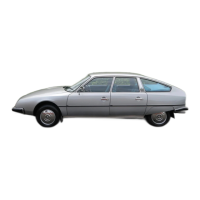0..
A..
A-.
A..
'T1
CG]
lam"
A-.
7S'
tfn
..,
7c'
O..
..ö
.-q
,.,
i:.
i..
.ty
.:,
E-+
Cl.
.h4
...
r.+
,z.
.'C
'-'
i.,
6
OPERATION N°
MÅ.
450-00
:
(baraclcristics
((ud s/?ccI0I fia/urcs
of tbc
brakiu
sv
5/uni,
FIG. 1
/
1976
(Ioc/('s
The
brake
pressure
limiter consists mainly
of a
slide-valve, the
position of
which
aliows
or
does
not
allow supply
of fluid under pressure
from
the
brake volve
to the rear
brakes.
-
one
end
of
the
slide-volve is constantly subjected
to
the pressure
of
the rear
suspension
1
luid
(
which
varies according to the bad
-
the other
end
of
the
slide-valve is subjected
to
force
Ri, increased during
braking
action by force
Fl exerted
by
the
fluid under pressure
from the
rear
brokes
o
)
Vuhicie iii th
c
«
bo'
»
positir)u (co flressuru
Under the action
of force
Ri
alone, the
slide-
valve is in
the
position
shown on Fig.
1.
The
fluid
cannot flow
from the brake
valve to
the
reor
brokes.
On
the
other hund,
the
one-way valve
aliows fluid
to flow
from the
rear
brakes
to
the
brake-valve.
b
)
Vuhi
cl
u ic
1/1 c
I/O
rio
al
(fri lic
po Si
1101/.
ti'i
ih
no
act/ou ou tho brak u pudal
Force
F
exerted
by
the
rear suspension
fluid
under
pressure is qreater
thon force
RI
produced
by
the
spring. The slide-volve is in the
position shown
on
Fig.
2
which
aliows fluid
to flow from the brake
volve to
the rear brakes ond
vice-versa.
c
)
1'
ch, cl ic
iiiot/ou.
uith
the brak e pedal be/og
acizialud
Fluid
flowing from
the rear
brakes,
exerts
a
force
Fl
which is
added
to force
Ri
produced
by
the spring.
B
cfr)
le «
OU t0 (II
»
At
the start
of
the
brake pedal
movement,
force
Fl
being still
very
small,
we have
Fl
+
Ri
(F. The
slide-valve
aliows
Iiquid to flow to
the
rear
brakes.
fl/ter
«
cii
1-0 Ut
»
Force
Fl
having
increased, and being odded
to
Force
Rl,
we have
Fl
+
RI>
F.
The slide-valve
interrupts
the
flow of
fluid
to
the
reor
brakes.
The
easing
» of
the braking at the rear is then
allowed
to
proceed via
the
one-way
valve.
NOTE
Fl
H-
Rl> F
is true
when the rear
brake
pressure
+
28
bars
(
406
psi
)
becomes greater
than
the rear
suspension
pressure.
If
F
increases,
Fl increases as well until cut-out
occurs.
Consequently,
maximum
pressure in
the rear
brakes increases.
FIG.
2
£
PDF compression, OCR, web-optimization with CVISION's PdfCompressor

